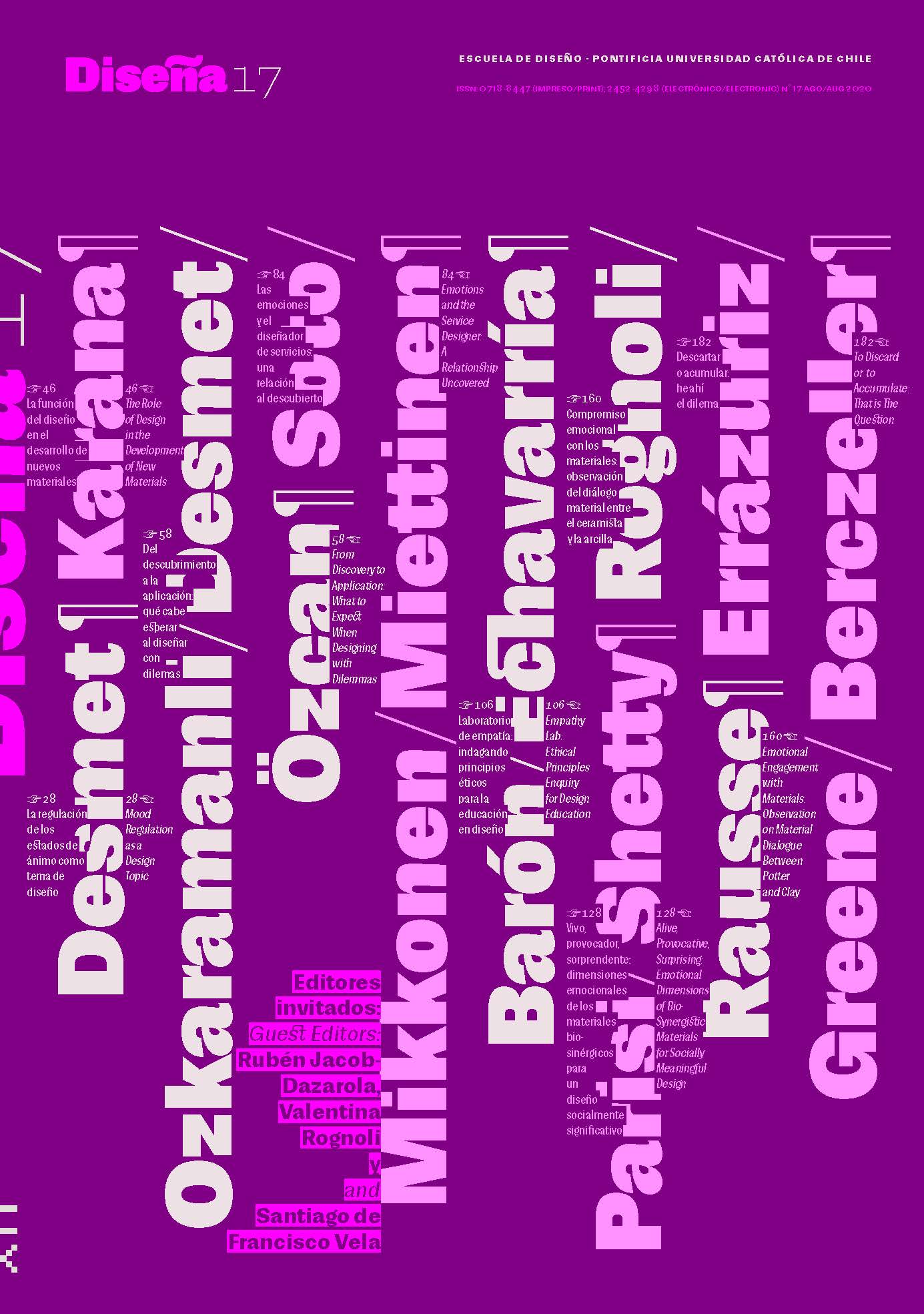Las emociones y el diseñador de servicios: una relación al descubierto
Contenido principal del artículo
Resumen
Las emociones están presentes en todo el proceso de diseño de servicios, afectando a cada uno de los participantes. Sin embargo, rara vez se ha abordado, en la investigación en diseño, la propia experiencia emocional de los diseñadores. Este artículo se centra en el papel que juegan y el significado que adquieren las emociones identificadas por los diseñadores de servicios en sus propias experiencias al conducir o participar en proyectos o como facilitadores de workshops. Se basa empíricamente en un cuestionario cualitativo para examinar sus experiencias y reflexiones sobre las emociones que identificaron en el transcurso de su práctica. Los hallazgos indican que existe una variedad significativa de emociones y una cierta confusión al determinar su conexión con el proceso general. Comprender las emociones asociadas con este proceso podría fortalecer las habilidades específicas de los diseñadores de servicios, mejorar la confianza en la toma de decisiones y agregar valor a su trabajo. Esto, a su vez, podría ayudar a los diseñadores de servicios a mejorar su desempeño profesional para crear una práctica de diseño más inclusiva y centrada en el usuario en el contexto de escenarios cambiantes, entornos variables y la complejidad de las interacciones humanas.
Detalles del artículo

Este obra está bajo una licencia de Creative Commons Reconocimiento-CompartirIgual 4.0 Internacional.
NOTA DE COPYRIGHT
Todos los contenidos de esta edición electrónica se distribuyen bajo licencia Creative Commons de “Atribución-Copartirigual 4.0 Internacional” (CC-BY-SA). Cualquier reproducción total o parcial del material deberá citar su procedencia.
Los derechos de las imágenes publicadas pertenecen a sus autores, quienes otorgan a Diseña la licencia para su uso. La gestión de los permisos y la autorización de publicación de las imágenes (o de cualquier material) que contenga derechos de autor y sus consecuentes derechos de reproducción en esta publicación es de exclusiva responsabilidad de los autores de los artículos.
Citas
BLOCH, S. (2008). Surfeando la ola emocional. Uqbar Editores.
BOHM, D. (2014). On Dialogue. Routledge.
CSIKSZENTMIHALYI, M. (1990). Flow. Harper Collins.
CUREDALE, R. A. (2013). Service Design: 250 Essential Methods. Design Community College.
DESIGN COUNCIL. (2005). Eleven Lessons: Managing Design in Eleven Global Brands. A study of the Design Process. https://www.designcouncil.org.uk/sites/default/files/asset/document/ElevenLessons_Design_Council%20(2).pdf
DESMET, P. M. A. (2002). Designing Emotions. Delft University of Technology.
DOETSCH-KIDDER, S. (2012). Social Change and Intersectional Activism: The Spirit of Social Movement. Palgrave Macmillan US. https://doi.org/10.1057/9781137100979
EKMAN, P. (1971). Universals and Cultural Differences in Facial Expressions of Emotions. In J. K. Cole (Ed.), Nebraska Symposium on Motivation 1971 (Vol. 19, pp. 207–283). University of Nebraska Press.
EKMAN, P. (2004). Emotions Revealed: Understanding Faces and Feelings. Phoenix.
FRIJDA, N. H. (1986). The Emotions. Cambridge University Press.
FRIJDA, N. H. (1988). The Laws of Emotion. The American Psychologist, 43(5), 349–358. https://doi.org/10.1037//0003-066x.43.5.349
GEORGE, J. M., & DANE, E. (2016). Affect, Emotion, and Decision Making. Organizational Behavior and Human Decision Processes, 136, 47–55. https://doi.org/10.1016/j.obhdp.2016.06.004
HEKKERT, P., & MCDONAGH, D. (2003). Design and Emotion. The Design Journal, 6(2), 1–3. https://doi.org/10.2752/146069203789355453
HOOKS, BELL. (2003). Teaching Community: A Pedagogy of Hope. Routledge.
IZARD, C. E. (2009). Emotion Theory and Research: Highlights, Unanswered Questions, and Emerging Issues. Annual Review of Psychology, 60(1), 1–25. https://doi.org/10.1146/annurev.psych.60.110707.163539
KUURE, E., MIETTINEN, S., & ALHONSUO, M. (2014). Change through Service Design – Service Prototyping as a Tool for Learning and Transformation. In Y. Lim, K. Niedderer, J. Redström, E. Stolterman, & A. Valtonen (Eds.), Proceedings of DRS 2014: Design’s Big Debate (Vol. 1, pp. 469–482). Umeå Institute of Design.
LEAVY, P. (2017). Research Design: Quantitative, Qualitative, Mixed Methods, Arts-Based, and Community-Based Participatory Research Approaches. The Guilford Press.
LERNER, J. S., LI, Y., VALDESOLO, P., & KASSAM, K. S. (2015). Emotion and Decision Making. Annual Review of Psychology, 66(1), 799–823. https://doi.org/10.1146/annurev-psych-010213-115043
MATTELMÄKI, T., VAAJAKALLIO, K., & KOSKINEN, I. (2014). What Happened to Empathic Design? Design Issues, 30(1), 67–77. https://doi.org/10.1162/DESI_a_00249
MIETTINEN, S. (Ed.). (2017). An Introduction to Industrial Service Design. Routledge. https://doi.org/10.4324/9781315566863
MIETTINEN, S., & SARANTOU, M. (2019). Managing Complexity and Creating Innovation through Design. Routledge.
MIKKONEN, E. (2017). Bridges over the Mountain Ranges: Ethnography on the Complexities of Transition in Women’s Social Position in Nepalese Rural Communities [Doctoral Dissertation, Lapland University]. https://www.ulapland.fi/news/Bridges-over-the-Mountain-Ranges-Ethnography-on-the-Complexities-of-Transition-in-Women’s-Social-Position-in-Nepalese-Rural-Communities/jbtleocy/9981802a-d361-4c52-8c93-7bdd1f5118a4
NORMAN, D. (2004). Emotional Design: Why we Love (or Hate) Everyday Things. Basic Books.
PAN, S., SARANTOU, M., & MIETTINEN, S. (2019). Design for Care: How the “Good Old Days” can Empower Senior Residents to Achieve Better Services in an Aged-Care Institution. The International Journal of Design in Society, 13(2), 25–40. https://doi.org/10.18848/2325-1328/CGP/v13i02/25-40
PLUTCHIK, R. (1980). Emotion: A Psychoevolutionary Synthesis. Harper & Row.
POLAINE, A., LØVLIE, L., & REASON, B. (2013). Service Design: From Insight to Inspiration. Rosenfeld Media.
RIVANO ECKERDAL, J., & HAGSTRÖM, C. (2017). Qualitative Questionnaires as a Method for Information Studies Research. Information Research, 22(1), CoLIS paper 1639. http://informationr.net/ir/22-1/colis/colis1639.html
SANDERS, E. B.-N., & STAPPERS, P. J. (2008). Co-creation and the New Landscapes of Design. CoDesign, 4(1), 5–18. https://doi.org/10.1080/15710880701875068
SANGIORGI, D., & PRENDIVILLE, A. (Eds.). (2017). Designing for Service: Key Issues and New Directions. Bloomsbury Academic.
SOTO, M., BEAULÉ, C., ALHONSUO, M., & MIETTINEN, S. (in press). Emotions: The Invisible Aspect of Co-creation Workshops. In Proceedings of the 6th International Conference on Design Creativity (ICDC 2020). University of Oulu, Finland.
STICKDORN, M., HORMESS, M. E., LAWRENCE, A., & SCHNEIDER, J. (2018). This is Service Design Doing: Applying Service Design Thinking in the Real World. O’Reilly.
STICKDORN, M., & SCHNEIDER, J. (2011). This is Service Design Thinking: Basics, Tools, Cases. Wiley.
THALER, R. H., & SUNSTEIN, C. R. (2009). Nudge: Improving Decisions About Health, Wealth, and Happiness. Penguin Books.
TOLOSA, M. R. (2008). A Twist in Communication the Power of the Oasis (SSRN Scholarly Paper ID 1310227). Social Science Research Network. https://doi.org/10.2139/ssrn.1310227
TOLOSA, M. R. (2013). Communities and Social Network, the Collapse of Pyramids. Papyrbit.

